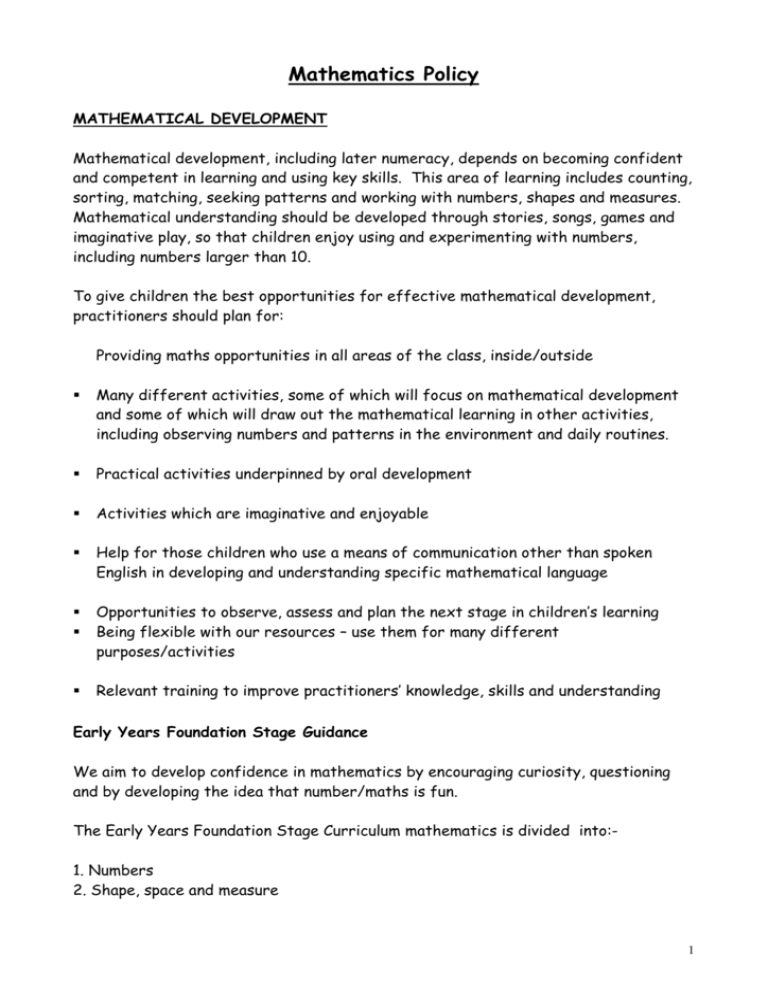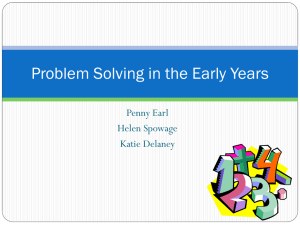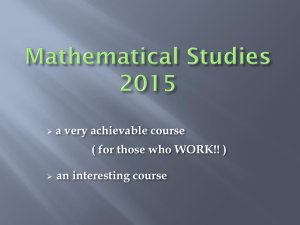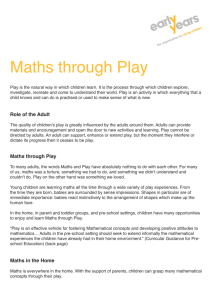HUNTINGDON NURSERY SCHOOL – MATHEMATICS POLICY
advertisement

Mathematics Policy MATHEMATICAL DEVELOPMENT Mathematical development, including later numeracy, depends on becoming confident and competent in learning and using key skills. This area of learning includes counting, sorting, matching, seeking patterns and working with numbers, shapes and measures. Mathematical understanding should be developed through stories, songs, games and imaginative play, so that children enjoy using and experimenting with numbers, including numbers larger than 10. To give children the best opportunities for effective mathematical development, practitioners should plan for: Providing maths opportunities in all areas of the class, inside/outside Many different activities, some of which will focus on mathematical development and some of which will draw out the mathematical learning in other activities, including observing numbers and patterns in the environment and daily routines. Practical activities underpinned by oral development Activities which are imaginative and enjoyable Help for those children who use a means of communication other than spoken English in developing and understanding specific mathematical language Opportunities to observe, assess and plan the next stage in children’s learning Being flexible with our resources – use them for many different purposes/activities Relevant training to improve practitioners’ knowledge, skills and understanding Early Years Foundation Stage Guidance We aim to develop confidence in mathematics by encouraging curiosity, questioning and by developing the idea that number/maths is fun. The Early Years Foundation Stage Curriculum mathematics is divided into:1. Numbers 2. Shape, space and measure 1 1) NUMBERS Used in everyday situations – house, building, streets, car registration numbers. Numbers used to select television channels, microwave food etc. Children will begin to recognise numbers and learn some number names. They will see number in the setting, know how old they are and start to mark make to record. Children should experience and learn about number through planned, adult led activities, spontaneous activities and play. There are many opportunities for matching one to one e.g snack time – counting and estimating/recording using tally sheets: cups to saucers, cake to cake tin, plate to child, etc. More abstract opportunities can be supported through board games and picture matching. This involves saying number names in order, matching numbers to objects counted, knowing that you use one number for each object you count and that the last number you say gives the number of objects in the group, and later that counting involves knowing that the number in a group is the same even if the objects are counted in a different way. Counting will be carried out at every opportunity. Number rhymes counting games, dice games, ring games will be used to re-enforce number understanding and make it fun. This section is about using numbers in practical contexts making logical deductions, making estimations. Using the language of more than, less than. Asking questions – ‘who do you think is tallest/smallest’. It involves comparing numbers of objects [leads to subtraction] combining numbers [addition] and sharing objects equally between some children or grouping objects in 2’s or 3’s [division, multiplication], objects can be actual objects or events like number of jumps. 2. SHAPE, SPACE, AND MEASURE [2 Dimensional and 3 Dimensional Objects/shapes] We believe that experiencing the properties of shapes is more important than the naming of shapes, although the correct mathematical label for shapes will be used by staff. Shape Children will develop an awareness of shape by recognising similarities and differences and being able to distinguish the properties of shape [which will roll, which will stay flat on a table, how many edges/face corners a shape has] It requires being able to identify and name some familiar shapes in the environment, [shape of windows, plates, cans of food, packets of cereal.] 2 Space Materials will be provided that fit together, take apart and build. Children will have opportunities for problem solving through play and construction, junk modelling and matching. They will be encouraged to talk about what they are doing and can be encouraged to use some shape or positional language. Children will extend their spatial awareness through handling objects inside and outside. Dance, movement, and gross motor activities enable children to develop their awareness of themselves in space. Building opportunities in the block room. Measurement and Time Understanding measure develops from activities such as packing, filling and emptying bags and containers or making something fit. Measuring involves being able to compare sizes and quantities. This can be by direct comparison [standard units] or by finding something to compare it with [strip of paper for hat measuring]. A sense of pattern, through measurement of time comes through talking about day and night time, weekends, weekdays. A regular routine of the nursery session helps children anticipate and plan (visual timetables/visual clues). Children will be able to compare short periods of time with uniform non-standard units. [Large egg timer a task/activity like pedalling around the track.] Activities like cooking, weighing, balancing.] Methods of Teaching Through individual opportunities to work with children during their play Through adult led mathematical activities Through small group teaching As a response to environmental/locational/investigative activities at the nursery Through inside and outside activities Through modelling Progression will be developed through Weekly and termly planning Individual targets for children Through observation, monitoring and assessment Through delivery of the Early Years Foundation Stage Framework Assessment and Record Keeping [refer to policy] Opportunities for staff to moderate judgements 3 [Guidance Assessment with exemplars] Entry assessment current level of understanding Assessment through observation systems in the Nursery aligned with delivery of the planned curriculum Evidence to substantiate child’s progress Planned observation Conversations with children Recordings – photo’s, video Samples of work Analysing the ‘evidence’ to decide on the implications and responding to them through the planning process Pupil progress is recorded in yellow files and transferred onto assessment sheets. Reporting to Parents Informal opportunities to share achievements Formal opportunities to share pupil progress Photographic evidence of children’s mathematical experience in children’s books to share with parents Written reports that give a summative account of pupil progress Reference to other policies: All foundation stage curriculum area policies Teaching and learning policy Assessment and record keeping policy Reviewed; January 2014 Review: January 2017 4 RESOURCES FOR MATHEMATICAL DEVELOPMENT Large/small boxes, beads, buttons, pegs, plastic containers, bottle tops. Leaves, flowers, stones, twigs, conkers, collections of objects for sorting/classifying. Large/Medium/Small bricks Sand, water, clay, dough and equipment that develops this play Cookery equipment and ingredients outdoor activities P.E. opportunity observing growth of plants sets of graded objects art straws/pipe cleaners number jigsaws money/food items for shopping purses/shopping trolley & list growth charts books including counting and rhyme pictures, posters & friezes puzzles, board games charts computer software programmes measuring equipment, scales, balance number lines – adjustable and fixed climbing apparatus indoors/outside printing blocks and collage material mirrors Soft Toy Maths ICT equipment e.g. remote control/programmable toys MATHEMATICAL RESOURCES IN THE ENVIRONMENT house numbers size, tags, labels, tickets car number plates 5 clocks, egg timers calendars/birthday charts MATHS SONGS (NEW RESOURCE) Maths in the Foundation Stage Curriculum – reference material 6 7








